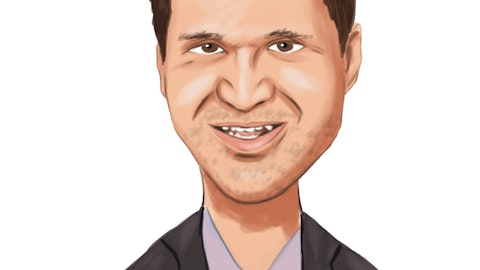John Kim: My final question is just a follow-up on Michael’s on the dividend. Your payout ratio on CAD was 118% last year. If you assume growth of 4% per annum that’ll take about five years to cover it. I’m assuming some of these development loans that you provide are probably not going to be cash — on a cash basis as far as the yield. Why not address the dividend now as you’re going through more of a growth strategy rather than a stability and high yields, focused strategy that you’ve had previously?
Meghan Baivier: Yes. I mean, John, we’re really taking a long view on this. And we have the fortunate ability to do so given the types and the nature of assets that we have in our portfolio. So, as Darrell said earlier, we’re really going to look at all the levers we have with regard to our same store portfolio to manage the payout levels. But we’re not looking just one, two quarters ahead. We’re really looking one, two years ahead and the opportunity that we see in front of us is one that we think we can sort of bridge into nicely.
John Kim: I mean, I would argue a payout ratio above 100%. It shouldn’t persist for more than a couple years, but we can talk about offline.
Operator: Our next question is from Michael Carroll of RBC.
Michael Carroll: Meghan, I know you touched on this in your prepared remarks, but how many leases are you currently on waiting on the TI build out before those rent escalators can be realized? I mean, should we see, I mean, is it a meaningful amount where there are some more embedded organic growth that’s not realized in your fourth quarter numbers now, but it will be realized once those TI projects are complete in the new renaissance?
Meghan Baivier: Yes. Mike, it’s — from a single tenant perspective it’s 11 then you’ve got a couple other of our smaller assets — smaller leases in Buffalo. So it’s 14 total leases for over 1 million square feet that are still going through the TI build out process.
Michael Carroll: How much, I guess, rent or incremental rent does that represent that could flow in through numbers?
Meghan Baivier: We can isolate that for you, Mike. But we’re we don’t know just yet where those full all in rents are going to land. So we’ve held back on that. But that subset really is the subset of assets that we’re looking for increases north of 25% on. So it’s a considerable tailwind with regard to the growth we’re talking about over the next one to two years.
Michael Carroll: And then that is going to come online in ’24 and ’25. So it’s a two year type time frame before that stuff gets kind of realized?
Meghan Baivier: Yes. So the vast majority of that, we expect to come on over the course of 2024, primarily in the back half of 2024. A bit of it could be expected 20% or so to flow over into 2025.
Michael Carroll: And then on the investment side, I mean, how do you plan on funding, I guess, new deals? I mean, before you can kind of pursue some of those transactions that you highlighted, does DEA need to raise equity to kind of to fund that? Is that kind of — what we should be expecting? So how aggressive you get really depends on where your cost of capital kind of trends?
Allison Marino: So we look to each deal with a mix of debt and equity tailored to that deal. But generally, we look to acquire 75 bps wide of our cost of capital considering both debt and equity sources.
Meghan Baivier: And yes, Mike, with our forward equity position today, yes, we look at deals relative to as Allison said the marginal cost of capital for the company and relative to that deal. But incremental external growth will require additional new capital.
Michael Carroll: And are you comfortable with your current leverage metrics right now? I mean, would you want to kind of trend lower from that 7%, 7% plus type range to a more midpoint of your longer term target?
Michael Carroll: So we’re sitting right at 7x from a adjusted net leverage perspective and so that’s a very — obviously very comfortable place for us.
Operator: [Operator Instructions] Our next question is a follow-up from Michael Griffin of Citi.
Michael Griffin: Just a quick question on the guidance. Curious if there is any capitalized interest embedded in the 2024 guide?
Meghan Baivier: So as we continue to build out, FDA Atlanta, yes, incremental borrowings would draw interest that we would be able to capitalize. So no change in that expectation. Obviously, I’ll development are treated that way.
Operator: Our next question is from Michael Lewis of Truist Securities.
Michael Lewis: I’m sorry if I missed this. I got on a little late. You did a few shares in the forward offering. I just wanted to ask about the pricing, right? The pricing on the shares was below consensus NAV by material amount. And I know this is a dangerous question, but how do you think about a price that you wouldn’t issue below or how do you kind of think about protecting the equity value?
Meghan Baivier: Yes, it’s a balance obviously, Mike. I think we’re seeing opportunities, where equity in that low $13 range makes a ton of sense. And those are certainly assets that are going to come wide to that type of implied cap rate weighted average cost of capital. And so to the extent we see those opportunities and they are maybe opportunistic, we will look to bring them in and consistent with our portfolio and help resume that growth path that we’re looking to get back on.



